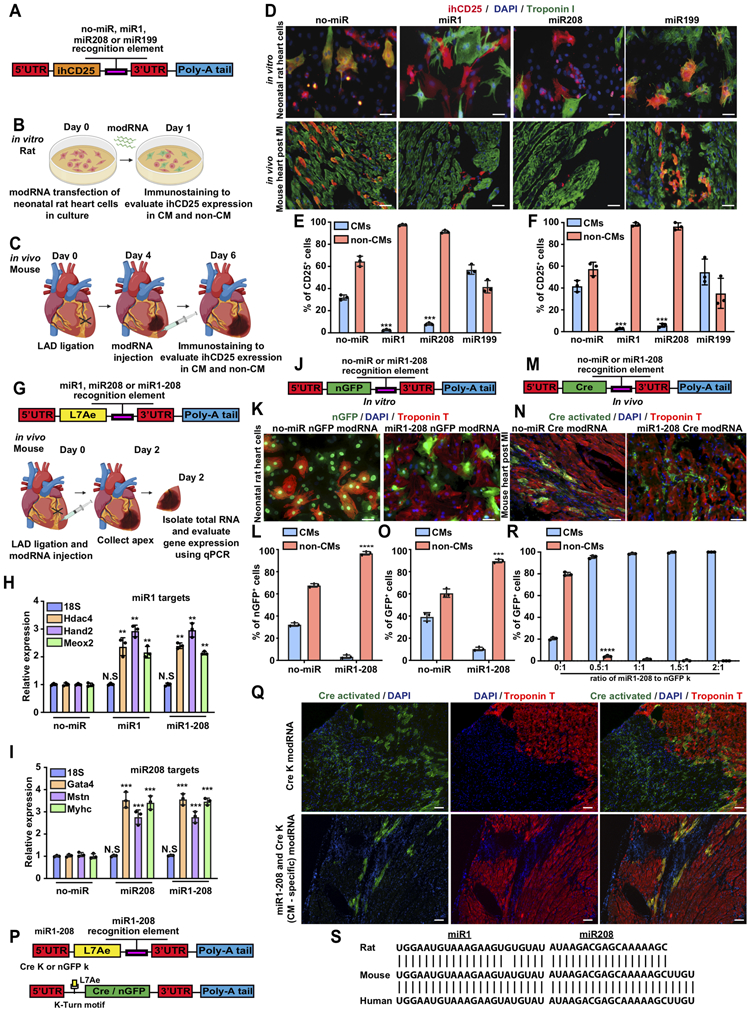Development of CM- and non-CM-specific modRNA expression platform.

A. Construction design for identifying CM-specific miRs (cmsmiRs) using inactive human CD25 (ihCD25) modRNA with or without recognition elements for known cmsmiRs post transfection. B&C. Experimental timeline for evaluating cmsmiRs expression in neonatal rat heart cells in vitro (B) and adult mouse MI model in vivo (C). D. Representative images of CD25 immunostaining (red) after delivery of ihCD25 modRNA with or without recognition elements for different miRs post transfection in neonatal rat heart cells in vitro (upper panel) and mouse MI model in vivo (lower panel). E&F. Quantification of the in vitro (E) and in vivo (F) experiments (n=3). G. Construct design and experimental timeline to analyze the inhibition of miR1 and miR208 target genes in mouse hearts 2 days after MI and delivery of modRNA with or without recognition elements for miR1 or/and miR208. H&I. qPCR evaluation of miR1 (H) and miR208 (I) target genes, 2 days post MI and delivery of modRNA with or without recognition elements for miR1 or/and miR208 (n=3). J. Construct design for SMRTs GFP non-CM-specific modRNA to be evaluated in neonatal rat heart cells in vitro. K. GFP immunostaining to evaluate nGFP modRNA expression (green) in neonatal rat CM (red) 1 day after delivery of nGFP modRNA with or without CM-specific recognition elements (miR1-208) in vitro (similar timeline as in B). L. Quantification of the experiment described in K (n=3). M. Construct design for SMRTs Cre non-CM-specific modRNA to be evaluated in vivo (similar timeline as in C) using Rosa26mTmG reporter mice in MI model (upon Cre expression, cells express GFP). N. GFP immunostaining to evaluate Cre modRNA expression (green) in non-CM and CM (red) 28 days post delivery of Cre modRNA with or without CM-specific recognition elements (miR1-208) in vivo. O. Quantification of the experiment described in N (n=3). P. SMRTs CM-specific GFP/Cre based on two modRNAs: one modRNA is a suppressor gene (L7AE) with miR1-208 recognition element upstream of its 3’UTR, and in the second modRNA the gene of interest is regulated by a K-motif downstream of its 5’UTR. Upon L7AE translation, the circuit modRNA binds to the K-motif and prevents translation of the gene of interest (Cre or nGFP). Upon transfection into CMs, L7AE is suppressed by endogenous miR1 or/and miR208. Lack of L7AE results in Cre or nGFP translation; however, in non-CM cells, L7AE is expressed and suppresses Cre or nGFP expression. Q. Rosa26mTmG reporter mice co-transfected with Cre-K alone or circuit modRNA (Cre-K+miR1-208, (CM-SMRTs Cre)) and analyzed 28 days post MI. R. Evaluation of different ratios of miR1-208 and nGFP k modRNA for delivery in an MI setting in vivo (similar timeline as in C). S. Sequence alignment of miR1 or miR208 in rat, mouse and human. Unpaired two-tailed t-test for E&F, L, O and S. One-way ANOVA, Tukey's Multiple Comparison Test for H&I. ****, P<0.0001, ***, P<0.001, **, P<0.01, Scale bar = 20μm (D (upper panel) and K), 50μm (D (lower panel) and N) and 100μm (Q).
